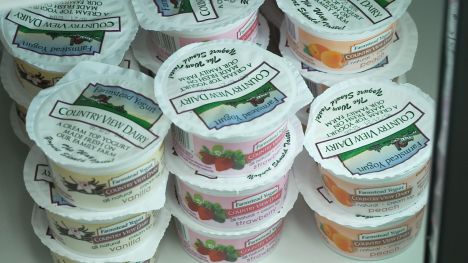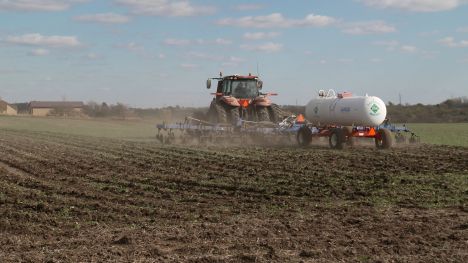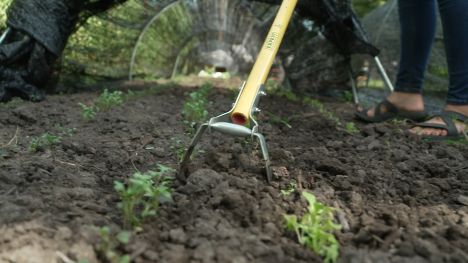
New Markets & Entrepreneurship
An entrepreneur is someone who envisions, creates, and runs a business. Entrepreneurs often use new ideas, methods, or business strategies in an attempt to make a profit. Agricultural entrepreneurs are generating new ideas, developing alternative methods of production, and tapping into new or emerging markets that could change agriculture well into the future.
What ideas do you have for a new agricultural product or market? Is there an unmet need just waiting for a solution? What would you need to make the product a success?
Pagination
- Page 1
- Next page
Background
New Markets & Entrepreneurship
An entrepreneur is someone who envisions, creates, and runs a business. Entrepreneurs often use new ideas, methods, or business strategies in an attempt to make a profit. If he or she is the sole proprietor and is not relying on outside capital from other investors, the entrepreneur also assumes all of the risks—and rewards—of the business. Agricultural entrepreneurs are generating new ideas, developing alternative methods of production, and tapping into new or emerging markets that could change agriculture well into the future.
Scholars and business leaders have identified a wide range of characteristics of successful entrepreneurs. Generally, entrepreneurs are determined and not averse to risk. They tend to be motivated more by their vision than a desire for quick profits. They often possess a variety of administrative, technical, and marketing skills prior to launching their own business. Successful entrepreneurs tend to be curious, which makes them more likely to identify overlooked niche, non-traditional markets; or new products and services.
Niche Markets
A niche market is a smaller, more-focused part of a larger market. An entrepreneur might select a niche market based on particular characteristics that make it a good business opportunity. For example, instead of growing the same soybean varieties as the majority of his or her neighbors, a farmer might choose to grow and roast food-grade varieties, or grow low-linoleic strains that possess health benefits.
One of the fastest-growing efforts to connect consumers with farmers is known as community supported agriculture (CSA). In the CSA model, groups of investors buy shares in a local operation. Local farmers then produce fruits and vegetables, and shareholders receive fresh produce each week during the growing season.
Other entrepreneurs have implemented more unorthodox production models, such as aquaponics. You may not envision a prairie dotted with large-scale agricultural operations as the best place to produce fish, but some entrepreneurs in the Grain Belt have developed sustainable, self-sufficient aquaponic systems that produce both fish and fresh produce. Some ideas or products are so different from traditional farming they are viewed as a totally new market. Agricultural tourism or "agritourism," as it's commonly known, offers an increasingly viable alternative for improving the income and sustainability of small farms and rural communities, while providing an opportunity for non-farmers to experience life on the farm.
New Markets for Energy
It's doubtful any new market has had a larger impact on rural America than energy production. And there's no greater example than the growth of biofuels. As America became increasingly dependent on foreign oil, policy makers began to embrace ethanol as a viable, homegrown method to quench a portion of the nation's increasing thirst for oil.
Other farmers are capitalizing on lucrative changes blowing in the wind. Massive turbines dot the landscape from North Dakota to Texas, generating significant amounts of power. Still other innovative energy projects are attempting to replace the amount of coal used to generate electricity with cleaner-burning renewable sources such as switchgrass.
Direct Marketing Models
Some producers prefer a more direct approach to reach their consumers, and often act as the producer, processor, and even the retailer of their goods. By maintaining control of their products—and enhancing them in some fashion—these farmers receive premium prices for their goods. Strategies for direct marketing might include targeted advertising, identifying customers who are seeking value-added products, and developing methods of production and sales to meet customer needs.
Emerging Markets
Any discussion of new markets must include emerging markets. The term "emerging markets" typically refers to foreign countries where the economy is growing, or prospects favor growth in the future. The economies are measured in terms of gross national product (GNP). GNP is the total value of the country's production and services—domestically and abroad—over the course of one year. Currently, China and India are the two largest emerging markets, and the top four are often referred to as BRIC (Brazil, Russia, India and China).
Emerging economies are attractive investments because they tend to grow rapidly resulting in higher returns for the investor. That potential reward, however, is accompanied by greater risks. Geopolitical uncertainties, agricultural subsidies, shifting currency values, infrastructure issues, and fluctuating supply and demand all can influence prices in emerging markets.
In an increasingly global and competitive landscape, entrepreneurial skills are as important as ever for many modern agricultural businesses. What ideas do you have for a new agricultural product or market? Is there an unmet need just waiting for a solution? What would you need to do to make the product a success?
Discovery Questions
- What personal characteristics do you think an entrepreneur must possess in order to be successful?
- Think of successful entrepreneurs throughout history. What factors do you think lead to their success?
- What types of risks might an entrepreneur encounter?
- Who benefits from new innovations and products from entrepreneurs?
- What role should government take in entrepreneurism and innovation?
- What can you learn from a successful company that has been around for many years?
- What steps might you take as an entrepreneur to ensure your idea is successful?
- What niche markets are you a part of?
- What are some risks of working with an emerging market?
Challenge
View and Print the Challenge | View and Print the Challenge Rubric
In an increasingly global and competitive landscape, entrepreneurial skills are as important as ever for many agricultural businesses. What ideas do you have for a new agricultural product or market? Is there an unmet need just waiting for a solution? What would you need to do to make the product a success?
Your challenge is to identify a new agricultural product or service, or a way to improve upon an existing product. Use these steps to help create your entrepreneurial plan.
1. Consider Opportunities
A great business often starts by solving a problem or thinking about an old product in a new way. Think about a product or service related to agricultural production, transportation, processing, packaging, finance, marketing, or retail. How does this product or service solve a problem or meet a need?
- Answer the questions below and generate a list of at least three new entrepreneurial opportunities. Use the videos and related resources on this site for examples of entrepreneurial ideas. You may also want to conduct research to identify problems or consumer needs that must be addressed:
- Is there a product or service that already exists that does not meet the expectations of its consumers?
- Is there a new scientific or technological development that can be adapted for agriculture?
- Do you have an idea for a completely new agricultural product?
- List your three opportunities, and briefly describe why they were selected and why you think they could be successful.
-
2. Define Your Product
- From your list, select one entrepreneurial opportunity you think would be a success.
- Define the need your product addresses.
- Why is this a good business opportunity?
- How is your product or solution different from what is currently available?
- What new benefit(s) does your product offer consumers? Does your product do something completely new? Does it take an idea that is already being used and make it better?
- Define your market by describing the characteristics and needs of your consumer.
- Now that you have identified the needs, you can start to envision your product or service that meets those needs. Consider different ways to describe your product, including a written description, list of features, a drawing, or a 3D design model.
- From your list, select one entrepreneurial opportunity you think would be a success.
-
3. Assess Risks
- Every new business venture involves taking chances. What risks can you identify related to launching your product? Questions to consider might include:
- Who are your competitors?
- How will your product get to the customer?
- Who will you need to hire for your team?
- What government regulations will need to be addressed?
- How will you obtain starting financing?
- Does the technology needed for your product exist?
- Identify and describe at least three risks that threaten the success of your product. For each risk you have identified, think of at least one way to address that risk. Considering these risks, why is your product a good business opportunity?
- Every new business venture involves taking chances. What risks can you identify related to launching your product? Questions to consider might include:
-
4. Create Your Proposal
- Prepare a presentation for potential investors. How will convince others your idea is worth investing in? This is your chance to be creative. Think of a way to showcase your idea, such as a website, brochure, video, essay, or poster. Your presentation should identify the problem being addressed, describe the target audience, and explain why your idea is the best solution to the market need. Be sure to include product details to help "sell" your idea.
Related Resources
- Biz Kids: Entrepreneurship
A collection of short video clips show the ins and outs of being a young entrepreneur, from brainstorming new ideas, to marketing a product, to selling to customers. Biz Kids - What is an Entrepreneur?
View a list of characteristics and skills you may want to acquire to improve your entrepreneurial ability. Iowa State University Extension, Ag Decision Maker - What If - Innovator Insights
Learn about Jeff Slobotski, the business development and ecosystem manager for Millwork Commons in Omaha, Nebraska. Jeff helps develop Millwork Commons, a community of innovative people and enterprises. PBS LearningMedia
Teacher Notes
Module Overview
The New Markets & Entrepreneurship module defines and describes entrepreneurs and the personal characteristics and skills required to be successful. Students will learn about agricultural opportunities such as niche markets, CSA's, aquaponics, agritourism, and new markets like ethanol and wind turbines. The resources discuss options of direct marketing models and defines and evaluates opportunities in emerging foreign markets.
This module introduces students to several big ideas. Successful farms and ag-related businesses have been built on new ideas, new products, new markets, new processing methods, new distribution/transportations methods and more. In an increasingly global and competitive landscape, entrepreneurial skills are increasingly important. Being an entrepreneur requires identifying unmet market needs and opportunities, an understanding of how to meet the need, and an assumption of risk. Entrepreneurs face many challenges and are not always successful.
Learning Goals
This module connects with the following learning goals:
- Define the importance and economic impacts of entrepreneurship in the agriculture industry.
- Simulate, on a small scale, the processes involved in entrepreneurship including idea generation, opportunity analysis, and risk assessment.
- Identify problems that a new product, service or process can solve.
- Model how business and marketing plans are utilized in entrepreneurial endeavors.
- Evaluate and prioritize strategies and tactics to achieve business goals in niche markets.
- Explain the impact outside entities, such as government or business, have on the entrepreneurship.
View and Print the Challenge | View and Print the Challenge Rubric




